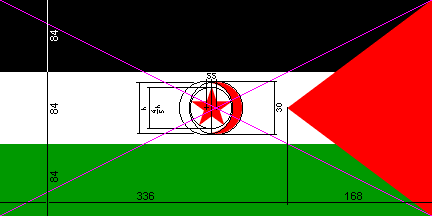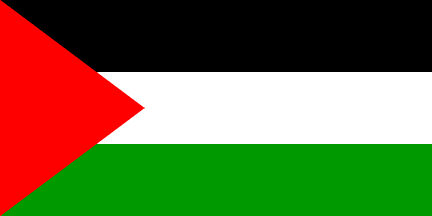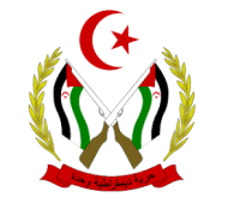
image by Željko Heimer, 01 Jan 2004 |

Last modified: 2024-02-17 by rob raeside
Keywords: western sahara | sahara | sahrawi arab democratic republic | sadr | crescent: points to fly (red) | crescent: points up (red) | pan-arab colours | polisario front | different reverse | map | puns | el ouali |
Links: FOTW homepage |
search |
disclaimer and copyright |
write us |
mirrors
 image by Željko Heimer, 01 Jan 2004 | |
* Editorial note: The Moroccan government considers Western Sahara as a part of its own territory. This page does not necessarily imply any partiality on the territorial issue in question, as also doesn’t the existence of our page about the flags of Moroccan administrative divisions, among which Western Sahara is included.
Flag adopted 27 February
1976, state emblem adopted 1976,
modified June 1991.
Nozomi Kariyasu, 2001
The flag (designed by the Frente Polisario) is inverted
in nature. The black (on top) represents death, the green represents life, the
white represents peace.
Brent Overton, 24 January 2000
The flag of the SADR follows the pan-Arab
colours and is similar to the PLO flag [now the flag of the
Palestine Authority, ed.], with the
addition of a crescent and star on the white stripe.
Stuart Notholt, 09 FFebruary eb 1996
POLISARIO was originally closely aligned with the Algerian regime.
So it is quite likely that the SADR flag’s star and crescent
would be like that of the Algerian flag.
Stuart Notholt, 09 February 1996
The POLISARIO flag and the SADR flag are the same. When Polisario
proclaimed the SADR their own flag was hoisted.
Jaume Ollé, 23 August 1998
I have recently read three books on West Sahara written by Japanese
journalists and found the article mentioning the national flag of SADR
was designed by El Ouali (1948-1976) founder of Frente Popular
para la Liberación de Saguía el Hamura y Río de Oro (Polisario)
prepared for its independence proclamation on Feb 27 1976. He respected
PLO and added red star and crescent to the flag. The
book shows flags but the shape is similar to Turkish
star and crescent and there are both flags with left and right hoists.
The green stands for wealth, red for martyr’s blood, white for hope,
black for colonialism and suppression, red star and crescent for
Islam.
Nozomi Kariyasu, 20 October 2007
 image by Željko Heimer, 01 Jan 2004 | |
The proportions are 1:2.
The height of the triangle is equal to 1/3 the length of the flag.
The centre of the circle which creates the outer arc of the crescent
is in the exact centre of the flag. The diameter of the circles which
create the outer and inner arcs of the crescent are equal to 5/7 the
width of the central stripe. The centre point of the circle
containing the star is to be found on an imaginary line connecting
the horns of the crescent, and has a diameter equal to 4/5 the
distance between the horns of the crescent. The centre points of the
circles which create the crescent and place the star are equidistant
along the horizontal meridian. (From a document issued by the Protocol
Section of the Office of the President of the Republic in June 1987.
The image above is my interpretation of the official figures for Western
Sahara, although flags in practice almost certainly don’t follow
them.)
Christopher Southworth, 01 January 2004
This does not quite define the distance between the two circles
determining the crescent, but from the sketches he sent me together
with the above, it seems obvious that the distance is 1/6 of the
diameter of each of the circles. (The center of the circle defining
the star is, by virtue of construction requists that it lays on the
same line as the hrons of the crescent, exactly at the midpoint
between the two circles defining the crescent.)
Željko Heimer, 01 January 2004
The design of the flag of Western Sahara is credited to the founder of
POLISARIO, El Ouali (full name, Ouali Sayed) - above. Another founding member of
POLISARIO, Mahjoub Salek, presents a different history in an interview given to
Yabiladi, 7 May 2018.
Salek claims to have been member of the committee
in charge of the elaboration of the POLISARIO's emblems and principles during
the movement's second congress, held in 1974. "I was not inspired by the
Palestinian flag, which I did not know at the time. The flag of POLISARIO
reflects our revolutionary ideals. Red represents blood, black evokes the
colonization period, white highlights our revolution, and green personifies the
values of edification. The star and crescent means our Arab character and our
Muslim identity."
Salek further explains that "other members of the committee
proposed a yellow flag charged in the middle with a crescent, a star and a
camel".
Following the presentation of the two proposals, the congress
eventually selected Salek's design.
https://www.yabiladi.com/articles/details/64562/autre-mahjoub-salek-drapeau-polisario.html
Yabiladi, 7 May 2018
Mahjoub Salek founded in 2004 a
dissident movement, Khat Achahid. He believes that the POLISARIO became a puppet
in the hands of the Algerian government, which blocks any negotiation and
maintain the status quo for political reasons. He adds that this would never had
happened if Ouali Sayed had not been killed during a raid against Nouakchott
(Mauritania). Accordingly, Salek remains faithful to Sayed and there is no
reason to believe that his claims on the authorship are illegitimate. It could
be that Sayed, as the head of POLISARIO, eventually validated Salek's design.
Ivan Sache, 18 July 2018
Before Spanish Sahara was a unified province
it was divided in two provinces, the Saguiat el-Hamra (the "SA"
of "polisario"… and the "EH" of the
ISO country code) and Rio de Oro (the
"RIO"). The "POLI" means "por la
liberación" ("for the liberation"). Spanish Sahara
was also known as Spanish West Africa, but that one included other bits like
Ifni (to Morocco in 1969), Cape Juby (the southernmost part of Morocco not
including WS) and La Aguera.
Joàn-Francés Blanc, 16 November 1999
When the Spanish pulled out of this territory
in 1976, it was partitioned between Morocco, which
took the larger part, and Mauritania. Local
nationalists of the POLISARIO movement proclaimed the Sahrawi Arab Democratic
Republic on 27 February 1976.
Stuart Notholt, 09 February 1996
Since 1997, after internal borders changed: regional flags unknown; in Western Sahara 2 almost complete regions and part of a third:
The Polisario Flag was at first a party flag. When Spanish troops
yielded control of the country to Morroco
(Marcha verde), Polisario
proclaimed the SADR on 27 February and hoisted same flag (like
FLNA and Algeria).
At that time the SADR would be a single party country and logically the
identification between party symbol and state symbol was total. More than
half of Africa (and many others countries in the world) recognized SADR
and it was accepted in the African Union
Organization. The SADR-POLISARIO flag was very popular and no change
was ever proposed.
Jaume Ollé , 20 November 1999
The United Nations now seem to accept a new plan concerning the
political future of Western Sahara. Since Morocco and POLISARIO have
not been able to reach an accord on a self-determination referendum
(the problem is who is allowed to vote in this predominantly nomadic
region), UN will prefer to postpone the decision, form an autonomous
region within Morocco, and (maybe) organize the referendum in five
years.
Jan Zrzavy, 26 June 2001
From the Association de soutien à un référendum libre et régulier au Sahara Occidental (Western Sahara) newsletter:
On the eve of the anniversary of the Polisario Front, threats and intimidations against Saharawi activists increased in the occupied territories and southern Morocco, the police looking for leaflets and Saharawi flags.
An example:
20.05.03 - An emissary of the pacha of El Ayoun paid a visit to a Saharawi defender of human rights, Lidri Elhoucine, to ask him to go to the office of the pacha, which Lidri refused because there was no official summons. The same evening the pacha himself, who was following Lidri in his car, told him he knew about his “separatist” activities. The pacha threatened him with arrest if the Polisario flags, which he was accused of possessing, were distributed. Lidri is a professor of philosophy, a member of the former executive of the Forum for Truth and Justice in El Ayoun, his name figures on the list of 18 Saharawis accused in the case concerning the dissolution of the FVJ Sahara section.
Zane Whitehorn, 24 May 2003
 image by Željko Heimer, 01 Jan 2004 | |
I saw a Western Sahara flag that had the crescent and star only on [what we might at first call] the reverse. Of course this may be interpreted as:
"Obverse" means "main side" (and thus "reverse" means "secondary side"), usually the side shown in construction sheets and other flag depictions, the side where inscriptions or emblems are applied (when these are applied on one side only), the side turned outwards when the flag is arranged for indoor limp display, etc. Usually, in left to right cultures the obverse is the side with the hoist at the viewer’s left hand ("dexter hoisted"), and in right to left cultures the obverse is the side with the hoist at the viewer’s right hand ("sinister hoisted").
This being so, and considering that the flag spotted by Santiago looked like this
o________ ________o |\_______| |_______/| | )______| |__*)__( | |/_______| |_______\| | | | |then the flag is indeed sinister hoisted and has a different reverse (no emblem). The obverse is the side showing the emblem — because it shows the emblem.
 image by Željko Heimer, 01 Jan 2004 | |
When the Polisario gain independence after a referendum and are recognized
as a “true country” the green will go on top and the black will
go to the bottom.
Brent Overton, 24 January 2000
 image by António Martins, 12 July 2004, based on report by Jaume Ollé, 20 Nov 1999 | |
I believe the flag with a map of the Western Sahara in the center
is fictional.
Jaume Ollé, 20 November 1999
What was this flag? Some non-islamic Saharawi fraction or supporter
movement?
António Martins, 12 July 2004
 image by Eugene Ipavec, 19 February 2010
image by Eugene Ipavec, 19 February 2010
In a Yahoo News photo of street protesters in Spain from last year
(ephemeral url, but detail here), a variant
of the EH flag can be seen. (The protests were against Morocco’s
expulsion of Western Sahara independence activist Aminatou Haidar to Spain,
where she had started a hunger strike at Lanzarote Airport.)
Eugene Ipavec, 19 February 2010
The French text in white capital letters, "SAHARA" (in the
black stripe) / "LIBRE" (in the green stripe), reads "free
Sahara".
Ivan Sache, 20 February 2010

 images located by BlinxCat, 20 May 2022
images located by BlinxCat, 20 May 2022
A flag belonging to the disputed SADR in Western Sahara, This flag is a
square white flag with fringe carried in front of a group of soldiers(?)
carrying the national flag behind.
BlinxCat, 20 May 2022